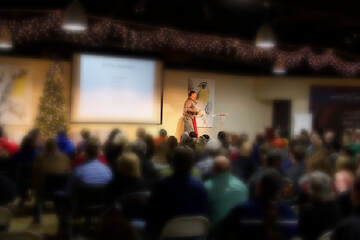Bridging Leadership Lessons from the Workplace and Those Experiences Shaping Today's Youth and Tomorrow's Leaders
 As a lifelong learner, I enjoy all types of training. Whether it’s listening to audiobooks while on the treadmill, attending webinars on leadership or attending in-person training on personal development, I love to expand my perspective and experiences. I had spent years giving presentations at group and company meetings on all sorts of topics. I was very comfortable with the mic, and I was effective in allowing my personality and passion for the topic to create an entertainment that would hold their attention while keeping people laughing and engaged. So, when I was approached by HR to provide training to new employees on Change Management and Strategic Planning, I jumped at the chance. While making the move to be on the stage from sitting in the audience was an easy adjustment for me, I quickly realized that there was a big difference between receiving training class and giving training. I eagerly began to put together the presentation slides knowing that I could share my passion and energy with the audience. After my first session, it became apparent that being an entertaining presenter was not the same as being a good trainer. Making a class enjoyable is a key point of training so that the participants are receptive to the content and message. But when I sought feedback from the attendees on my training, all the feedback was focused on my delivery and not the content. Basically, my content was forgettable, but they enjoyed hearing what I had to say. The HR Director at the time, provided some suggestions on including activities that would help reinforce the message of the training. She also pointed out that I was essentially providing a lecture or motivational talk but failed to establish a dialogue that helped attendees connect and would maximize the impact of the time we were spending together. Recognizing that if I needed to bring value to those in the training, I needed to put into practice what I enjoyed about learning and make changes to my slides, my content, and my approach. I implemented small group discussions, on stage demonstrations and used flip charts to gather input from the audience. The very next classes I taught, I received excellent feedback on the surveys making my classes the highest rated classes over the next couple of years. Recently, my perspective on training changed once again. While I was still out in front, on the stage, what changed was who was sitting in the seats. I was approached by an outside organization to provide leadership training to a group of managers based upon my blog series, the 3 Pillars of Impact. I was honored and excited about the opportunity to share my experiences and perspective with people outside of my organization. It was another opportunity to make an impact on others which is why I started this blog initially. I began the process of taking my three-part blog series, The 3 Pillars of Impact, and converting them into three distinct training modules: The Courage to Challenge, Expect Excellence & Empower Others. Fortunately, I was able to utilize an outline I had previously put together to support a video series on this blog that I had made for my work. As I began to flesh out the content, it dawned on me that I had lost my biggest advantage to my previous training - these people don’t know who I am. My prior experience was in providing required training for work. It was a targeted audience and was at a company that I had grown up in with so many relatable stories that I could tell providing connections to the past. I was an Executive with years of service in the company which automatically provided some credibility on why they should listen and participate in my training. My examples will now need to be explained to others who have no history. Some of these examples I wouldn't be able to use because they are deemed confidential. I had known that my view as a trainee was different from that as a trainer, but it took me a little longer to realize how different a view it would be moving again to an outside trainer. Each change in perspective puts me down a different path with a different set of questions. A different set of answers. My topics and approaches needed to pull the audience together. To align their perspectives, but also highlight the differences. Creating an environment of sharing between a diverse group of managers regarding age and experience but also with familiarity with each other and their roles in the larger organization. We know changing perspective is always valuable for growth and understanding. Many times, the perspectives change when we change roles. But sometimes, the perspectives can change while performing the same role. These changes can be triggered when the environment changes or maybe because you have learned a little more than before. Because the leader you are today will always be different from the leader you will be, Beyond Today.
0 Comments
Leave a Reply. |
AuthorTom Brown - a husband and a father who is simply trying to make a difference. Using my experience as a Manufacturing Executive to connect leadership from the boardroom to the hardwood to help teams grow and develop to make a difference in the lives of others. Archives
May 2024
Categories |
Proudly powered by Weebly

 RSS Feed
RSS Feed

